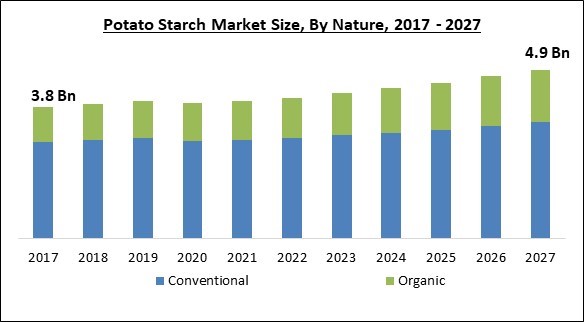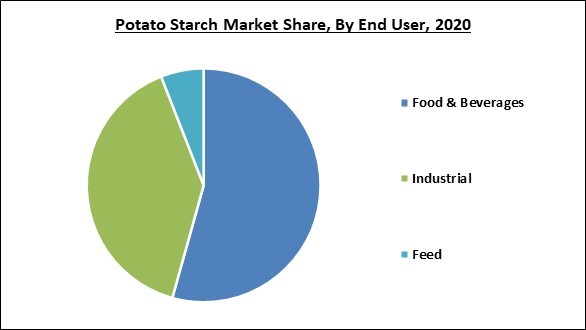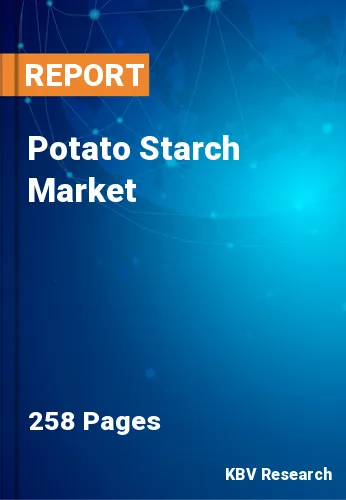The Global Potato Starch Market size is expected to reach $4.9 billion by 2027, rising at a market growth of 3.5% CAGR during the forecast period.
Potato starch is a native starch extracted from potatoes. The root tubers cells of the potato plant contain starch gains also known as leucoplasts. It is extracted by crushing and washing the potatoes, to form milky liquid. Later on, starch is washed finely and dried to form a powder. Potato starch contains a minimal amount of fats and protein level which gives the potato starch powder a fine clear white color.
The cooked potato starch is preferred over other starch due to its high binding strength, long texture, good clarity, the minimum tendency to yellowing and foaming, and neutral and flavorless taste. Starch contains about 800 parts per million phosphates, which increases the viscosity of the starch and gives anionic character to the solution.
The potato crop is cultivated at a large scale across the world. It has certain properties, such as thermal and shear resistance, a high tendency of retrogradation, and low thermal decomposition. Potato starch is one of the most common ingredients used by chefs in the cooking process. Starch is commonly used in the making of pastries, pasta, pieces of bread, tortillas, and noodles. They are used to improve the texture of the food used in the native state, as relatively unrefined cereal grain flours.
As compared to corn starch, potato starch can resist higher heating temperatures while cooking or baking. The potatoes starch has the lowest amylose content than other starch. It helps in supporting the health issues like stabilizing blood sugar, lowering cholesterol, and supporting healthy colonic bacteria. Low amylose is preferred for Chronic Inflammatory Response Syndrome (CIRS), Small Intestinal Bacterial Overgrowth (SIBO), and another fungal and bacterial dysbiosis.

COVID-19 had both positive and negative impacts on the overall potato starch market. COVID-19 has affected almost every industry; there would be a long-term effect of the pandemic on the industry growth during the forecast period. The food industry was affected most by the lockdown imposed on various outlets and restaurants, which forced people to cook at home. Due to the lockdown, the production and distribution of potatoes tend to decrease in the market. The cost of the potatoes hiked up during the lockdown period. The sales of the packaged food increased as every consumer rushed to stock up their pantries in the lockdown. Self-cooking has increased the utilization of potatoes and its starch in different food processors.
Convenience is one of the biggest drifts in the food business. In most of the developed countries, it’s a part of the daily diets of the consumer. Convenience food requires extensive preparation and processing, which requires technological innovations in packaging, freezing, artificial flavoring, ingredients, and preservatives. Changing in lifestyle and increase in the adaption of convenience food in the countries across the globe are contributing to the demand for various food products. Food items like snacks, bread, salted food, cheese, baked item have been sold for a long period. Some of the convenience food is prepared with development in food technology. These convenience foods are developed on regular basis to make them more interesting for the consumers.
As a resistant starch, potato starch is a good source to normalize blood sugar levels. Many starches fall in the category of resistant starch food. These starch travel through the digestive system without being changed. The resident starch found in potatoes is rich satiating than other starchy carbohydrates. Unripe bananas are another example of resistant starch. The bacteria in the small intestines process the starch to create good molecules, without digesting in the intestine which helps to balance blood sugar levels. Consuming 15 to 30 grams of resistant starch consumed by overweight or obese man, for four weeks can improve insulin sensitivity compared to people who do not consume resistant starch.
The starch market has a wide range of varieties such as corn, rice, wheat, arrowroot starch, and many other sources. Most of the starches have the same multiple similarities with different nutrient and chemical-based contents. These starches are the perfect substitute for potato starch-based on their requirements. Sweet rice flour can be used as an alternate in gluten-free baking. It has higher starch content and is stickier as compared to regular rice. Due to its gluten-free nature, it has a better binding capacity and helps in mixing ingredients. Additionally, corn starch is the biggest competitor of potato starch, as it has its own taste and fried food crispier. Cornstarch is made up of white endosperm at the heart of a corn kernel. The endosperms are crushed into a white fine gritty powder known as cornstarch.

Based on End User, the market is segmented into Food & Beverages (Bakery & Confectionery, Beverages, and Processed Food & Others), Industrial (Paper Industry, Pharma, Cosmetics, Biodegradable Plastics, and Others), and Feed. The Industrial segment witnessed a significant revenue share of the potato starch market in 2020. Potato starch is widely used in every industrial sector such as textile, wood, pharmaceutical, as an adhesive, filler, and texture agent. It is also used to wash boreholes for oil drilling firms. It works as a substitute agent for polystyrene and other plastics used in making of dishes, knives, and disposable plates. Liquefied potato peel starch is fermented to produce fuel-grade ethanol.
Based on Type, the market is segmented into Modified and Native. The modified segment recorded the highest revenue share of the potato share market in 2020. Modified starches are classified on the basis of starch extraction from vegetables and grains. These starch are developed to improve certain characteristics to bring structure and texture to the food. The modified segment does not mean genetically modified. Based on the process, every starch gets its specific properties according to food preparation techniques.
Based on Nature, the market is segmented into Conventional and Organic. The Organic segment acquired a significant revenue share in the potato starch market in 2020. Organic potato starch is grown and extracted naturally, no pesticides and harmful chemicals are used in the processor of these starch. These starches provide organic nutritional values to the human body.
| Report Attribute | Details |
|---|---|
| Market size value in 2020 | USD 4 Billion |
| Market size forecast in 2027 | USD 4.9 Billion |
| Base Year | 2020 |
| Historical Period | 2017 to 2019 |
| Forecast Period | 2021 to 2027 |
| Revenue Growth Rate | CAGR of 3.5% from 2021 to 2027 |
| Number of Pages | 258 |
| Number of Tables | 530 |
| Report coverage | Market Trends, Revenue Estimation and Forecast, Segmentation Analysis, Regional and Country Breakdown, Companies Strategic Developments, Company Profiling |
| Segments covered | Type, Nature, End User, Region |
| Country scope | US, Canada, Mexico, Germany, UK, France, Russia, Spain, Italy, China, Japan, India, South Korea, Singapore, Malaysia, Brazil, Argentina, UAE, Saudi Arabia, South Africa, Nigeria |
| Growth Drivers |
|
| Restraints |
|
Based on Regions, the market is segmented into North America, Europe, Asia Pacific, and Latin America, Middle East & Africa. Europe region emerged as the leading region in the potato starch market with the highest revenue share in 2020. A total of 30% of the total starch is produced in Europe. Potatoes are the major feedstock in this region. Germany contributes the most to the production of potato starch.
Free Valuable Insights: Global Potato Starch Market size to reach USD 4.9 Billion by 2027
The market research report covers the analysis of key stake holders of the market. Key companies profiled in the report include Ingredion, Incorporated, Tate & Lyle PLC, AGRANA Beteiligungs-AG, Royal Ingredients Group B.V., Royal Avebe U.A., Sudstrake GmbH, Emsland Group, KMC Ingredients Company, Tereos S.A., and Roquette Freres SA.
By End User
By Type
By Nature
By Geography
The potato starch market size is projected to reach USD 4.9 billion by 2027.
Increasing demand in convenience foods are driving the market in coming years, however, competition from the alternate products limited the growth of the market.
Ingredion, Incorporated, Tate & Lyle PLC, AGRANA Beteiligungs-AG, Royal Ingredients Group B.V., Royal Avebe U.A., Sudstrake GmbH, Emsland Group, KMC Ingredients Company, Tereos S.A., and Roquette Freres SA.
The Conventional segment acquired maximum revenue share in the Global Potato Starch Market by Nature in 2020, thereby, achieving a market value of $3.3 billion by 2027.
The Europe is the fastest growing region in the Global Potato Starch Market by Region in 2020, and would continue to be a dominant market till 2027.
Our team of dedicated experts can provide you with attractive expansion opportunities for your business.

